Excessive tension in the back muscles causes a lot of discomfort and pain. Osteochondrosis, which causes a violation of the structure of the vertebrae and intervertebral discs, leads to serious entrapment of the nerve endings. Often the pathology is accompanied by a deterioration in blood circulation, which leads to disorders in the nutrition of the brain and internal organs.
Osteochondrosis - what is it?

Osteochondrosis is a recurring type of disease that occurs in a chronic form and is associated with destruction of the vertebrae with intervertebral discs. Their tissues are disturbed, which leads to a decrease in the degree of elasticity, followed by a change in shape. The intervertebral space gradually decreases. This leads to a loss of stability of the spine in the areas of pathology development.
The processes of pathological tissue destruction take place against the background of pinched nerve endings, directed from the area where the spinal cord is located. As a result, the back muscles are in constant tension. In such a situation, patients complain of back pain and other symptoms.
Based on the peculiarities of the localization of the structures of the spine, which were covered by degenerative changes, the cervical, thoracic and lumbosacral types of the pathological process are distinguished. The main symptom of the development of osteochondrosis is pain, the intensity and severity of which usually increase with physical exertion.
There is also stiffness in movement. In addition, the clinical picture is characterized by the presence of signs of the vertebral type - headache, changes in blood pressure, deterioration in visual function, hearing, etc.
Development mechanism
The development of osteochondrosis is associated with the fact that the nucleus pulposus begins to lose its hydrophilic properties. This semi-fluid structure contains connective tissue fibers and chondroitin, a gelatinous substance. During the development process of the human body and its growth, the processes of reduction of the vascular bed in the intervertebral discs take place actively. Nutrients are supplied diffusely, which manifests itself in the spontaneous stabilization of the concentration. This feature becomes the reason for difficulty in fully restoring the cartilage that has suffered damage or excessive pressure on the spine.
Pathological abnormalities become more noticeable due to violations of the hormonal background and human nutrition. The cartilage tissue lacks the nutrients needed for its normal development. Therefore, errors occur in the form:
- decrease in strength and elasticity;
- changes the consistency parameters and configuration properties.
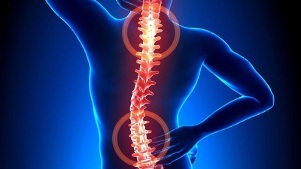
Against the background of the flattening of the intervertebral discs, radial cracks form in the fiber rings. As a result, the intervertebral spacing is reduced and the facet joints begin to shift. Over time, pathological changes cover types of connective tissue associated with the fibrous rings and ligaments.
When tissues are broken down by the immune system, increased amounts of immunoglobulins are produced. This provokes the development of the process of aseptic inflammation, edema arises in the area where the facet joints are located. They also spread to the adjacent soft tissues.
By stretching the joint capsules, the intervertebral discs lose their ability to fix the vertebrae. Such instability in the position of the structure of the spine increases the risk of pinching the nerve roots or squeezing the blood vessels. This feature is typical, for example, of cervical osteochondrosis, which is accompanied by intense verbal symptoms.
Causes of the disease
The condition of the intervertebral discs can worsen with a decreased tone of the skeletal muscles in the spine. Due to the irrational and asymmetrical work of the muscles, with prolonged maintenance of the unphysiological position of the body, destruction of the cartilage tissue can occur. This injury is the result of carrying heavy bags on the same shoulder with soft mattresses and high pillows.
The process of destruction of intervertebral discs is accelerated by the action of a number of negative factors, external and internal. These include:
- disorders of the endocrine mechanism and metabolic disorders;
- pathologies of an infectious nature, including in chronic form;
- Injuries to the spine in the form of compression fractures, bruises;
- regular and persistent hypothermia of the body;
- diseases of the systemic and degenerative-dystrophic types - gout, psoriasis, rheumatoid arthritis, osteoporosis, osteoarthritis;
- smoking and alcohol abuse, which disrupts the state of the vascular system, affects blood circulation and causes a lack of nutrients in cartilage;
- insufficient physical development, problems with posture, flat feet - these defects increase the load on the spine, since the amortization is insufficient;
- obesity;
- genetic predisposition;
- exposure to regular stress.
Symptoms
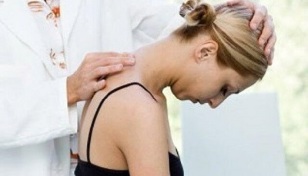
The most important clinical sign of osteochondrosis of a localization (cervical, thoracic or lumbosacral) is the pain syndrome. In the event of a relapse, the pain penetrates into nearby areas of the body. With a slight movement, it increases. This forces the patient to bring the upper body into a forced position to minimize discomfort and pain:
- With cervical osteochondrosis, it is preferable to turn not a head, but the whole body.
- If the disease is in the breast shape, it is difficult for the patient to breathe deeply. In order to rule out acute chest pain, he tries to minimize the depth and frequency of breathing.
- Patients with lumbar spine disease experience difficulty sitting down, standing upright, and moving around when the spinal nerve becomes pinched.
Usually, patients complain of dull, persistent pain and a feeling of stiffness in movements the morning after they wake up. In this case, differential diagnosis is needed to eliminate the risk of myositis, which is caused by inflammation of the skeletal muscles or osteoarthritis.
Pain and tenderness occur due to tension in the muscle tissue. This condition is necessary to stabilize the range of motion of the spine. Constant mild or moderate pain can occur with significant stretching of the intervertebral disc, leading to aseptic inflammatory changes.
The osteochondrosis of a separate location is characterized by special symptoms:
- With cervical osteochondrosis, pain is felt in the cervical zone and in the upper limbs. Headache and numbness of the fingers are observed. If the disease manifests itself in a severe form, it may cause pinching of the vertebral artery. In this case, the patient complains of a significant deterioration in health.
- The localization of the chest cavity manifests itself in acute and painful back pain. The visceral pain syndrome occurs in the heart area, in the right hypochondrium and in the abdomen. The patients complain of numbness, paresthesia of the skin, shortness of breath and crunching in the vertebrae.
- Patients with lumbar osteochondrosis complain of pain in the back and lower limbs with increased intensity during movement. Dysfunction of the genitourinary system, problems with male potency, and dysfunctional ovarian disorders are often diagnosed. The pain may subside during remission. However, the effects of a provoking factor lead to its renewal.
- If mixed osteochondrosis manifests itself, the symptoms can manifest themselves in several zones at the same time. This condition is characterized by a more severe course of the disease.
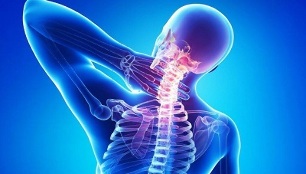
It should be noted that the displacement of the vertebrae and the formation of osteophytes cause compression of the vertebral artery. It nourishes the brain and supplies its cells with an oxygen component. When squeezing, food is limited and therefore the patient has problems with coordination, headaches, tinnitus and arterial hypertension.
Consequences if left untreated
The reason for the complicated course of osteochondrosis is the relatively rapid formation of hernias in the intervertebral discs. Their appearance is associated with a displacement of the vertebral structure posteriorly. This leads to rupture of the posterior ligament of the longitudinal type, as a result of which the position of the intervertebral disc becomes unstable and its individual sections protrude into the area of the spinal canal. A hernia fracture occurs when a disc with a nucleus pulposus enters the canal area.
When pathological abnormalities appear in the vertebral structures, the back of the brain begins to squeeze and the patient develops discogenic myelopathy. The symptoms of this condition are associated with numbness and weakness in certain muscle groups of the upper and lower extremities. Paresis, muscle atrophy, and tendon reflexes manifest. In some cases there are problems emptying the bladder and bowel.
Herniated discs are dangerous when they squeeze the arteries that supply the spinal cord. The result of this pathology is the formation of ischemic zones, in which nerve cells were damaged and died. The manifestation of a neurological effect is expressed in dysfunction of motor skills, a decrease in the degree of tactility and a disruption of trophism.
Disease diagnostics
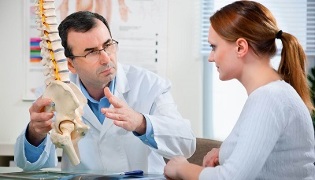
The initial diagnosis is based on the patient's complaints and symptoms. The specialist examines the condition of the spine in different positions, which suggests that the patient is at rest or in motion. In the next phase, the patient is directed to laboratory diagnostics to clarify or refute the diagnosis.
The methods of applied research include:
- Radiography- offers a complete examination of the spine with an assessment of the condition of the vertebrae, existing disorders in the form of growths, curvatures. The specialist can determine the intervals of the type of intervertebral vertebrae and the condition of the holes. To accurately identify the osteochondrosis located in the chest or cervical area, a two-stage X-ray examination is performed. In the first stage, the patient lies on his side and in the second, directly on his back.
- The method of tomography using MRI or CTprovides extremely informative data, with the help of which the vertebrae can be examined in detail without affecting the shape of the organs covering them. The picture shows the nerves and the vascular system. The MRI helps identify the signs of many spinal disorders and the location of the damage. With CT, hernias are made visible and possible deviations in the structure of the spine are determined.
- Laboratory examinationto assess the blood status and its main parameters. Allows you to clarify the diagnosis and determine the possibility of the development of concomitant diseases.
In many cases, based on exams, doctors diagnose the presence of some background diseases that may be dangerous to their complications. For example, we are talking about hernias, protrusion, radiculitis. Correct diagnosis of problems will help treat osteochondrosis effectively. At the same time, even in the early stages of development, the disease is camouflaged as a symptom of other diseases.
Therapeutic process
Osteochondrosis is treated conservatively or surgically. The choice depends on the severity of the disease, its neglect, the degree of tissue deterioration and the causes.
It is important to remember that it is not possible to completely cure osteochondrosis because there are no drugs that will help to fully restore intervertebral discs and vertebrae. The therapeutic effect is focused on inhibiting the destruction process and increasing the duration and stability of remission.
For symptomatic therapy, chondroprotectors based on chondroitin sulfate or glucosamine are used.
The effectiveness of the therapeutic process when using chondroprotectors has been clinically confirmed by long-term tests. If you take these funds for a longer period, from 3 months, there is a partial restoration of cartilage and other elements of the connection type - the ligament-tendon apparatus bursa.
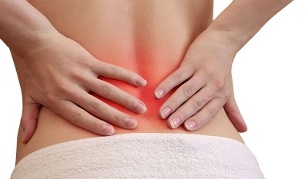
The accumulation of glucosamine and chondroitin in the area of the intervertebral discs leads to the manifestation of analgesic, anti-edematous and anti-inflammatory effects. Hence, there is a real opportunity to optimize the dosage of NSAIDs, glucocorticosteroid group drugs, and muscle relaxants. You can expect a reduction in the patient's drug exposure.
The effectiveness of chondroprotectors is determined by the regularity of their intake. Otherwise no result will be shown. Ineffectiveness is also noted in the treatment of 3rd degree osteochondrosis, accompanied by significant destruction of cartilage.
The following groups of drugs can be used for pain relief:
- Nonsteroidal anti-inflammatory drugshelp eliminate inflammatory diseases in soft tissues caused by vertebral displacement. NSAIDs are effective in reducing pain, swelling, and stiffness.
- Glucocorticosteroid group drugs- blockages are usually used in conjunction with an anesthetic. They are able to relieve pain, restore the immune mechanism and have an anti-exudative effect.
- muscle relaxants.They are effective in fighting muscle cramps due to nerve entrapment. They help relax the muscles of the skeleton and block reflexes of the polysynaptic spinal column type with antispasmodic properties.
- External means with a warming effect.The irritation of the receptors of the subcutaneous tissue with activation of the blood flow is carried out by special gels and ointments. These drugs have analgesic and anti-edematous effects.
It is possible to get rid of the symptoms of the vertebrogenic type, which are manifested as a result of the localization of the pathology in the cervical or chest zone, with the help of medical devices designed to activate blood flow. Nootropics and drugs to improve microcirculation are also prescribed. In some cases, you may need to take antidepressants, as well as medicines containing anticonvulsants.
Physical therapy is also used during treatment for osteochondrosis. Procedures for UHF therapy, magnetotherapy, laser therapy, reflexology, massage, exercise therapy, hirudotherapy, and swimming and yoga can be prescribed. If conservative treatment is ineffective, surgery is performed using microdiscectomy, puncture disc valorization, laser reconstruction, or implant replacement.





































